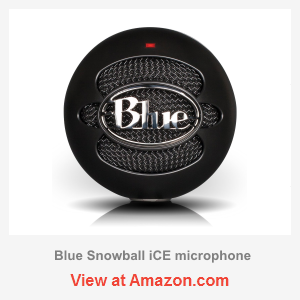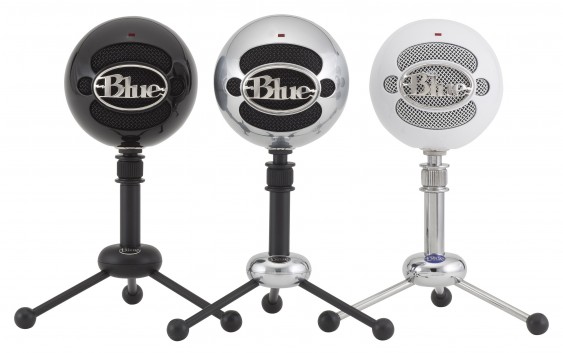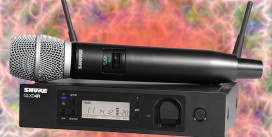Blue Snowball iCE is a stylish, entry USB mic with an attractive price tag. Unlike the similar-shaped Samson Meteorite, it is not as blatantly hot and it has a detachable USB cable with a solid Type B connector. The midrange is by far superior and technically, it produces a much more accurate sound than the former. However, there is literally nothing but midrange. It sounds thin and dark at the same time, and it also produces popping. A bit weird combo – isn’t it? I would say, this mic is fine for thing like skype and online gaming, but it may actually sound too dull for podcasting and voiceovers.
Snowball iCE vs. Snowball
Snowball iCE is a relatively new build – the original Snowball model has been in the market for well over fifteen years. However, the new build did not bring any new features but removed the old ones. This move allowed them to reduce the retail price significantly and make it far more worthwhile to purchase. The removed features were switchable -10 dB pad and omnidirectional capsule. This is a good move as they were useless anyway. Snowball always lacked gain so no one ever touched that pad and the omni mode probably has been the shittiest in the world – muffled like crazy and very inconsistent.
Sound & quality
Once again, comparing to Samson Meteorite, I was surprised to see the same awkwardly wide polar response, which could be more accurately described as sub-cardioid. So those looking for a tighter pick up in order to isolate the voice from the background will find it disappointing. However, Snowball Ice does not sound nearly as hot as Samson. The background still gets through but it sounds dampened, and therefore being perceived to a much lesser extent. Still, the race between the two reminds a bit of Special Olympics as both are handicapped compared to Shure MV5 with a naturally tighter cardioid.
 The capsule inside the Snowball doesn’t look bad at all. It’s roughly the same size as the ones used in Blue Yeti and each side of the capsule presents six openings where you can see a fine mesh. It is capable of producing a smooth sound without much of any distortion and hard resonances throughout the entire audible range. So yes, there is no harshness and no sibilance to be heard. It also features a relatively accurate midrange, which is crucial for vocals. Nevertheless it has a terrible EQ curve, which scoops out both the highs and the lows, literally leaving out nothing but midrange.
The capsule inside the Snowball doesn’t look bad at all. It’s roughly the same size as the ones used in Blue Yeti and each side of the capsule presents six openings where you can see a fine mesh. It is capable of producing a smooth sound without much of any distortion and hard resonances throughout the entire audible range. So yes, there is no harshness and no sibilance to be heard. It also features a relatively accurate midrange, which is crucial for vocals. Nevertheless it has a terrible EQ curve, which scoops out both the highs and the lows, literally leaving out nothing but midrange.
If you look at the frequency response in their manual, it somewhat correlates with what I am hearing; however, in reality the abyss between the lows, the mids and the highs is more prominent. The presence boost above 10 kHz is somewhat misleading because no USB DAC can adequately transmit it using the given sampling rate of 44.1 kHz. As a result, an actual graph would have the highs continuously rolling off even before reaching the 10 kHz mark. Needless to say, it will sound dark. And because of its unbalanced EQ response, an untrained ear could easily mistake its sound for a cheap 10$ headset.
However, if we were to adjust the EQ, Blue Snowball iCE would suddenly sound like a more expensive microphone. Too bad, there are no easy means for adjusting it, other than applying filters in your DAW, but in my opinion, this route sort of defeats the purpose of buying a cheap mic in the first place. And yes, there still remains a problem with popping. Even though the lows are neatly scooped out, and the sound is rather thin, strong plosives do get through and produce an odd amount of bass, all of a sudden. Of course, a pop filter would do it justice but again the Shure MV5 sounds fine even without it…
Build and durability
Blue Snowball Ice certainly has a flashy design, but one may wonder how durable it is? The mic itself is definitely durable. The plastic body is quite sturdy and it has no protruding controls or buttons. The only thing there is the USB port at the back but it’s really hard to mess up. Like all USB mics, it can fail if it falls flat on the ground, mainly due to the weakness of crystal oscillators. Nevertheless, it should work for a good while and a replaceable cable is another advantage. That being said, it has a terrible stand. Flimsy as it is, among all mics that we’ve reviewed it’s the only one that can’t be tilted vertically!
Pros
|
Cons
|










Very accurate review. Thanks!
I do like how you brought great attention to the darker frequency response. However, using the original Snowball for a couple years, im not bashing the Ice model all that much. After unboxing, physical inspection and a simple test after setting up a vocal chain to curve the eq discreps, it really does sound fine for the price. For popping, simply have the center places just above your upper lip. That also helps to bring out treble frequencies in the natural voice. Hope this was helpful. Good luck to everyone else giving this mic a try.